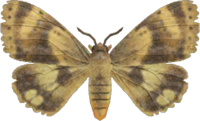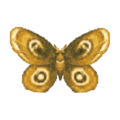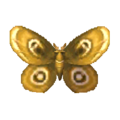Difference between revisions of "Moth"
SuperHamster (talk | contribs) m (Text replacement - "\| image = (.*) NH Icon\.png" to "| image = $1 NH Icon.png | render = $1 NH.png") |
AlexBot2004 (talk | contribs) (→In {{WW|short|nolink}}: Adding months) |
||
| (7 intermediate revisions by 6 users not shown) | |||
| Line 2: | Line 2: | ||
{{Distinguish|the [[Atlas moth]], [[Madagascan sunset moth]], or [[oak silk moth]]}} | {{Distinguish|the [[Atlas moth]], [[Madagascan sunset moth]], or [[oak silk moth]]}} | ||
{{Infobox Bug | {{Infobox Bug | ||
| − | |name = | + | |name = moth |
|ja-name = ガ | |ja-name = ガ | ||
|ko-name = 나방 | |ko-name = 나방 | ||
| Line 18: | Line 18: | ||
|family = {{wp|Saturniidae}} | |family = {{wp|Saturniidae}} | ||
}} | }} | ||
| − | The ''' | + | The '''moth'''{{Note|{{Nihongo foot|ガ|Ga}}}} is a [[bug]] in the {{SER}}. The moth first appeared in {{WW}} and has appeared in all subsequent games. Moths are also mentioned by [[Blathers]] in {{PG}} when a player donates a butterfly to the museum, although actual moths do not appear in that game. |
| − | In the games that the | + | In the games that the moth appears in, it is an uncommon bug that the player can encounter, and can be found flying around outside lights during the night. In {{NH}}, it can be caught all year. |
__TOC__ | __TOC__ | ||
| Line 26: | Line 26: | ||
===In {{WW|short|nolink}}=== | ===In {{WW|short|nolink}}=== | ||
{{WWBugInfo | {{WWBugInfo | ||
| − | |name = | + | |name = moth |
|number = 9 | |number = 9 | ||
|image = Moth WW Icon.png | |image = Moth WW Icon.png | ||
| Line 33: | Line 33: | ||
|availability = Mar – Sep | |availability = Mar – Sep | ||
|times = 7 PM – 4 AM | |times = 7 PM – 4 AM | ||
| − | |times-peak = 11 PM | + | |times-peak = 11 PM – 4 AM (Jun – Aug) |
| + | |m3=Yes | ||
| + | |m4=Yes | ||
| + | |m5=Yes | ||
| + | |m6=Yes | ||
| + | |m7=Yes | ||
| + | |m8-1=Yes | ||
| + | |m8-2=Yes | ||
| + | |m9-1=Yes | ||
| + | |m9-2=Yes | ||
|location = Near outdoor lights | |location = Near outdoor lights | ||
|bug-size = 60 mm | |bug-size = 60 mm | ||
| Line 91: | Line 100: | ||
===In {{NH|short|nolink}}=== | ===In {{NH|short|nolink}}=== | ||
{{NHBugInfo | {{NHBugInfo | ||
| − | | name = | + | | name = moth |
| number = 13 | | number = 13 | ||
| image = Moth NH Icon.png | | image = Moth NH Icon.png | ||
| Line 142: | Line 151: | ||
{{Blathers|CF|Many people hate moths, yet love butterflies, but the truth is that both belong to the order {{wp|Lepidoptera}}. Since both are covered in unspeakable veins and foul powder, I suggest they are equally distasteful.}} | {{Blathers|CF|Many people hate moths, yet love butterflies, but the truth is that both belong to the order {{wp|Lepidoptera}}. Since both are covered in unspeakable veins and foul powder, I suggest they are equally distasteful.}} | ||
| − | The | + | The moth can be found in the upper-left hand corner of the insect exhibit, flying around a lamp near the [[bagworm]]. |
===In {{NL|short|nolink}}=== | ===In {{NL|short|nolink}}=== | ||
| − | Upon being donated, the | + | Upon being donated, the moth can be found in the room of the bug exhibit with the light in, flying around the light. The exhibit has this to say about the moth: |
{{Blathers|NL|Moths are related to butterflies, but they're most often active at night instead of day. They use their large antennae to sense, smell, and guide themselves in the dark. Interestingly, the number of moth species is estimated at 160,000, so "moth" is a fairly broad descriptor.}} | {{Blathers|NL|Moths are related to butterflies, but they're most often active at night instead of day. They use their large antennae to sense, smell, and guide themselves in the dark. Interestingly, the number of moth species is estimated at 160,000, so "moth" is a fairly broad descriptor.}} | ||
| Line 158: | Line 167: | ||
==Names in other languages== | ==Names in other languages== | ||
{{Foreignname | {{Foreignname | ||
| − | |ja= ガ | + | |ja=ガ |
| − | |ja-r= | + | |ja-r=Ga |
| − | |ja-m= Moth | + | |ja-m=Moth |
| − | |es= Polilla | + | |es=Polilla |
|es-m=Moth | |es-m=Moth | ||
| − | |fr= Papillon de nuit | + | |fr=Papillon de nuit |
| − | |fr-m= Night butterfly | + | |fr-m=Night butterfly |
| − | |nl= Mot | + | |nl=Mot |
| − | |nl-m= Moth | + | |nl-m=Moth |
| − | |de= Motte | + | |de=Motte |
| − | |de-m= Moth | + | |de-m=Moth |
|it=Falena | |it=Falena | ||
|it-m=Moth | |it-m=Moth | ||
| − | |ko= 나방 | + | |ko=나방 |
| − | |ko-r= | + | |ko-r=Napang |
| − | |ko-m= Moth | + | |ko-m=Moth |
| − | |zh= 飞蛾 | + | |zh=飞蛾 |
| − | |zh-r= | + | |zh-r=Fēi-é |
| − | |zh-m= Moth | + | |zh-m=Moth |
| − | |zht= 飛蛾 | + | |zht=飛蛾 |
| − | + | |ru=Павлиноглазка | |
| − | + | |ru-r=Pavlinoglazka | |
| − | |ru= Павлиноглазка | + | |ru-m=Saturniid moth |
| − | |ru-r= Pavlinoglazka | ||
| − | |ru-m= Saturniid moth | ||
}} | }} | ||
| Line 188: | Line 195: | ||
{{Note list}} | {{Note list}} | ||
| − | {{Bugs}} | + | {{Navbox Bugs}} |
[[Category:Wild World bugs]] | [[Category:Wild World bugs]] | ||
[[Category:City Folk bugs]] | [[Category:City Folk bugs]] | ||
| Line 194: | Line 201: | ||
[[Category:Happy Home Designer bugs]] | [[Category:Happy Home Designer bugs]] | ||
[[Category:New Horizons bugs]] | [[Category:New Horizons bugs]] | ||
| + | |||
| + | [[es:Polilla]] | ||
Latest revision as of 23:36, May 5, 2024
| ||||||||
 | ||||||||
| Real-world info | ||||||||
|---|---|---|---|---|---|---|---|---|
| Name: Opodiphthera eucalypti Family: Saturniidae | ||||||||
| Main appearances | ||||||||
|
| ||||||||
| Other appearances | ||||||||
Names in other languages
ガ
飞蛾 Papillon de nuit Polilla Falena Павлиноглазка
나방 飛蛾 Papillon de nuit Polilla Motte Mot | ||||||||
The moth[nb 1] is a bug in the Animal Crossing series. The moth first appeared in Animal Crossing: Wild World and has appeared in all subsequent games. Moths are also mentioned by Blathers in Animal Crossing when a player donates a butterfly to the museum, although actual moths do not appear in that game.
In the games that the moth appears in, it is an uncommon bug that the player can encounter, and can be found flying around outside lights during the night. In Animal Crossing: New Horizons, it can be caught all year.
Catch details[edit]
In Wild World[edit]
| Description | Their antennae are large because they use their sense of smell to guide them in the dark. |
|---|---|
| Time of year | Mar – Sep |
| Time of day | 7 PM – 4 AM |
| Peak times | 11 PM – 4 AM (Jun – Aug) |
| Location | Near outdoor lights |
| Bug size | 60 mm |
| Selling price | |
| Furniture size |
In City Folk[edit]
| Description | These are similar to butterflies... but for some reason, hated by many people. |
|---|---|
| Time of year | May – Sep |
| Time of day | 7 PM – 4 AM |
| Peak times | Jun – Aug |
| Location | Flying near light sources |
| Bug size | 60 mm |
| Rarity | Common |
| Selling price | |
| Furniture size |
In New Leaf[edit]
| Time of year | May – Sep |
|---|---|
| Time of day | 7 PM – 4 AM |
| Peak times | Jun – Aug |
| Location | Flying near light sources |
| Size | 55 mm |
| Rarity | Very common |
| Selling price | |
| Furniture size |
In New Horizons[edit]
| Time of year | North: All year South: All year |
|---|---|
| Time of day | 7 PM – 4 AM |
| Location | Flying near light sources |
| Weather | Any except rain |
| Spawn requirement | Appears from the start of the game |
| Selling prices | |
| Furniture size |
Donating to the museum[edit]
In Wild World[edit]
In City Folk[edit]
The moth can be found in the upper-left hand corner of the insect exhibit, flying around a lamp near the bagworm.
In New Leaf[edit]
Upon being donated, the moth can be found in the room of the bug exhibit with the light in, flying around the light. The exhibit has this to say about the moth:
In New Horizons[edit]
It can be found at the leftmost point of the bug hall.
Gallery[edit]
Names in other languages[edit]
| ガ Ga |
Moth | |
| 나방 Napang |
Moth | |
| 飞蛾 Fēi-é |
Moth | |
| 飛蛾 Unknown |
||
| Павлиноглазка Pavlinoglazka |
Saturniid moth | |
| Mot | Moth | |
| Motte | Moth | |
| Polilla | Moth | |
| Papillon de nuit | Night butterfly | |
| Falena | Moth | |
Notes[edit]
| Bugs | ||||||||||||||||||||||||||
|---|---|---|---|---|---|---|---|---|---|---|---|---|---|---|---|---|---|---|---|---|---|---|---|---|---|---|
| ||||||||||||||||||||||||||






